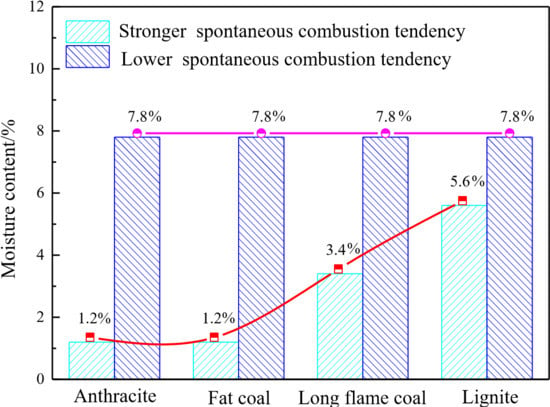Study on Spontaneous Combustion Tendency of Coals with Different Metamorphic Grade at Low Moisture Content Based on TPO-DSC
Abstract
:1. Introduction
2. Experiments and Methods
2.1. Coal Samples
2.1.1. Collection and Preparation
2.1.2. Preparation of Coal Samples with Different Low Moisture Content
2.2. Experimental Device and Process
2.2.1. Temperature Programmed Oxidation Experiment and Process
2.2.2. Differential Scanning Calorimetric Equipment and Process
3. Results and Discussion
3.1. Analysis of Temperature Programmed Oxidation Experimental Results
3.1.1. O2 Consumption Concentration
3.1.2. Analysis of CO and CO2 Production
3.1.3. Maximum Exothermic Strength
3.2. The Analysis for Scanning Calorimetric Experiment Results
3.2.1. The Analysis of the Zero Point of Heat Flow Difference and Endothermic Peak Temperature
3.2.2. The Analysis of Zero Point of Heat Flow Difference at the Same Low Moisture Content
4. Conclusions
Author Contributions
Funding
Conflicts of Interest
References
- Yang, Y.; Li, Z.; Si, L.; Gu, F.; Zhou, Y.; Qi, Q.; Sun, X. Study governing the impact of long-term water immersion on coal spontaneous ignition. Arab. J. Sci. Eng. 2016, 42, 1–11. [Google Scholar] [CrossRef]
- Choi, H.; Thiruppathiraja, C.; Kim, S.; Rhim, Y.; Lim, J.; Lee, S. Moisture readsorption and low temperature oxidation characteristics of upgraded low rank coal. Fuel Process. Technol. 2011, 92, 2005–2010. [Google Scholar] [CrossRef]
- Wang, X.; Luo, Y.; Vieira, B. Experimental technique and modeling for evaluating heat of rewetting effect on coals propensity of spontaneous combustion based on adiabatic oxidation method. Int. J. Coal Geol. 2018, 187, 1–10. [Google Scholar] [CrossRef]
- Wang, G.; Wang, Y.; Sun, L.; Song, X.; Liu, Q.; Xu, H.; Du, W. Study on the Low-Temperature Oxidation Law in the Co-Mining Face of Coal and Oil Shale in a Goaf—A Case Study in the Liangjia Coal Mine, China. Energies 2018, 11, 174. [Google Scholar] [CrossRef]
- Zhong, X.; Kan, L.; Xin, H.; Qin, B.; Dou, G. Thermal effects and active group differentiation of low-rank coal during low-temperature oxidation under vacuum drying after water immersion. Fuel 2019, 236, 1204–1212. [Google Scholar] [CrossRef]
- Tang, Y.; Xue, S. Influence of long-term water immersion on spontaneous combustion characteristics of Bulianta bituminous coal. Int. J. Oil Gas Coal Technol. 2017, 14, 398–411. [Google Scholar] [CrossRef]
- Miura, K. Adsorption of water vapor from ambient atmosphere onto coal fines leading to spontaneous heating of coal stockpile. Energy Fuels 2015, 30, 219–229. [Google Scholar] [CrossRef]
- MT/T 850-2000 (National Standard of China). China Coal Water Classification Industry Standards. Available online: http://www.doc88.com/p-1357829781036.html (accessed on 18 January 2000).
- Liu, X.; Hirajima, T.; Nonaka, M.; Sasaki, K. Experimental study on freeze drying of Loy Yang lignite and inhibiting water re-adsorption of dried lignite. Colloids Surf. A Physicochem. Eng. Asp. 2017, 520, 146–153. [Google Scholar] [CrossRef]
- Wang, H.; Dlugogorski, B.Z.; Kennedy, E.M. Coal oxidation at low temperatures: Oxygen consumption, oxidation products, reaction mechanism and kinetic modelling. Prog. Energy Combust. Sci. 2003, 29, 487–513. [Google Scholar] [CrossRef]
- Kim, J.; Lee, Y.; Ryu, C.; Park, H.Y.; Lim, H. Low-temperature reactivity of coals for evaluation of spontaneous combustion propensity. Korean J. Chem. Eng. 2015, 32, 1297–1304. [Google Scholar] [CrossRef]
- Zhang, K.; You, C. Effect of upgraded lignite product water content on the propensity for spontaneous ignition. Energy Fuels 2012, 27, 20–26. [Google Scholar] [CrossRef]
- Hu, Z.; Xia, Q. An integrated methodology for monitoring spontaneous combustion of coal waste dumps based on surface temperature detection. Appl. Therm. Eng. 2017, 122, 27–38. [Google Scholar] [CrossRef]
- Xiao, Y.; Lü, H.F.; Huang, A.C.; Deng, J.; Shu, C.M. A new numerical method to predict the growth temperature of spontaneous combustion of 1/3 coking coal. Appl. Therm. Eng. 2018, 131, 221–229. [Google Scholar] [CrossRef]
- Arisoy, A.; Beamish, B. Mutual effects of pyrite and moisture on coal self-heating rates and reaction rate data for pyrite oxidation. Fuel 2015, 139, 107–114. [Google Scholar] [CrossRef]
- Arisoy, A.; Beamish, B.; Yoruk, B. Moisture moderation during coal self-heating. Fuel 2017, 210, 352–358. [Google Scholar] [CrossRef]
- Xuyao, Q.; Wang, D.; Milke, J.A.; Zhong, X. Crossing point temperature of coal. Min. Sci. Technol. (China) 2011, 21, 255–260. [Google Scholar] [CrossRef]
- Yu, J.; Tahmasebi, A.; Han, Y.; Yin, F.; Li, X. A review on water in low rank coals: The existence, interaction with coal structure and effects on coal utilization. Fuel Process. Technol. 2013, 106, 9–20. [Google Scholar] [CrossRef]
- Kadioğlu, Y.; Varamaz, M. The effect of moisture content and air-drying on spontaneous combustion characteristics of two Turkish lignitesa. Fuel 2003, 82, 1685–1693. [Google Scholar] [CrossRef]
- Beamish, B.B.; Hamilton, G.R. Effect of moisture content on the R70 self-heating rate of Callide coal. Int. J. Coal Geol. 2005, 64, 133–138. [Google Scholar] [CrossRef]
- Deng, J.; Liu, W.Y.; Zhai, X.W.; Wen, H. Research on the Effects of Moisture on Oxidation and Spontaneous Combustion Properties of Mengba Coal Mine. Saf. Coal Mines (China) 2011, 42, 15–19. [Google Scholar]
- Song, S.; Qin, B.; Xin, H.; Qin, X.; Chen, K. Exploring effect of water immersion on the structure and low-temperature oxidation of coal: A case study of Shendong long flame coal, China. Fuel 2018, 234, 732–737. [Google Scholar] [CrossRef]
- Wang, H.; Dlugogorski, B.Z.; Kennedy, E.M. Role of inherent water in low-temperature oxidation of coal. Combust. Sci. Technol. 2003, 175, 253–270. [Google Scholar] [CrossRef]
- Zhang, Z.; Yan, K. Molecular dynamics simulation of oxygen diffusion in dry and water-containing brown coal. Mol. Phys. 2011, 109, 2367–2374. [Google Scholar] [CrossRef]
- Li, Y.; Zhao, H.; Song, Q.; Wang, X.; Shu, X. Influence of critical moisture content in lignite dried by two methods on its physicochemical properties during oxidation at low temperature. Fuel 2018, 211, 27–37. [Google Scholar] [CrossRef]
- Chen, X.D.; Stott, J.B. The effect of moisture content on the oxidation rate of coal during near-equilibrium drying and wetting at 50 C. Fuel 1993, 72, 787–792. [Google Scholar] [CrossRef]
- Zhao, H.; Yu, J.; Liu, J.; Tahmasebi, A. Experimental study on the self-heating characteristics of Indonesian lignite during low temperature oxidation. Fuel 2015, 150, 55–63. [Google Scholar] [CrossRef]
- Wang, W.; Wang, G.; Liu, H. Heat release regular pattern of different moisture content coal in low temperature. CSIRO Earth Sci. Resour. Eng. 2013, 94, 419–425. [Google Scholar]
- Xu, T.; Wang, D.M.; He, Q.L. The study of the critical moisture content at which coal has the most high tendency to spontaneous combustion. Int. J. Coal Prep. Util. 2013, 33, 117–127. [Google Scholar] [CrossRef]
- Li, J.; Fu, P.; Zhu, Q.; Mao, Y.; Yang, C. A lab-scale experiment on low-temperature coal oxidation in context of underground coal fires. Appl. Therm. Eng. 2018, 141, 333–338. [Google Scholar] [CrossRef]
- Wang, F.; Cheng, Y.; Lu, S.; Jin, K.; Zhao, W. Influence of coalification on the pore characteristics of middle–high rank coal. Energy Fuels 2014, 28, 5729–5736. [Google Scholar] [CrossRef]
- Yao, Y.; Liu, D. Comparison of low-field NMR and mercury intrusion porosimetry in characterizing pore size distributions of coals. Fuel 2012, 95, 152–158. [Google Scholar] [CrossRef]
- Wang, G.; Liu, Q.; Sun, L.; Song, X.; Du, W.; Yan, D.; Wang, Y. Secondary spontaneous combustion characteristics of coal based on programed temperature experiments. J. Energy Resour. Technol. 2018, 140, 082204. [Google Scholar] [CrossRef]
- Küçük, A.; Kadıoğlu, Y.; Gülaboğlu, M.Ş. A study of spontaneous combustion characteristics of a Turkish lignite: Particle size, moisture of coal, humidity of air. Combust. Flame 2003, 133, 255–261. [Google Scholar] [CrossRef]
- Tahmasebi, A.; Yu, J.; Su, H.; Han, Y.; Lucas, J.; Zheng, H.; Wall, T. A differential scanning calorimetric (DSC) study on the characteristics and behavior of water in low-rank coals. Fuel 2014, 135, 243–252. [Google Scholar] [CrossRef]
- Zhang, B.; Fu, P.; Liu, Y.; Yue, F.; Chen, J.; Zhou, H.; Zheng, C. Investigation on the ignition, thermal acceleration and characteristic temperatures of coal char combustion. Appl. Therm. Eng. 2017, 113, 1303–1312. [Google Scholar] [CrossRef]
- Cui, C.; Jiang, S.; Shao, H.; Zhang, W.; Wang, K.; Wu, Z. Experimental study on thermo-responsive inhibitors inhibiting coal spontaneous combustion. Fuel Process. Technol. 2018, 175, 113–122. [Google Scholar] [CrossRef]
- Feng, X.; Zhang, C.; Tan, P.; Zhang, X.; Fang, Q.; Chen, G. Experimental study of the physicochemical structure and moisture readsorption characteristics of Zhaotong lignite after hydrothermal and thermal upgrading. Fuel 2016, 185, 112–121. [Google Scholar] [CrossRef]
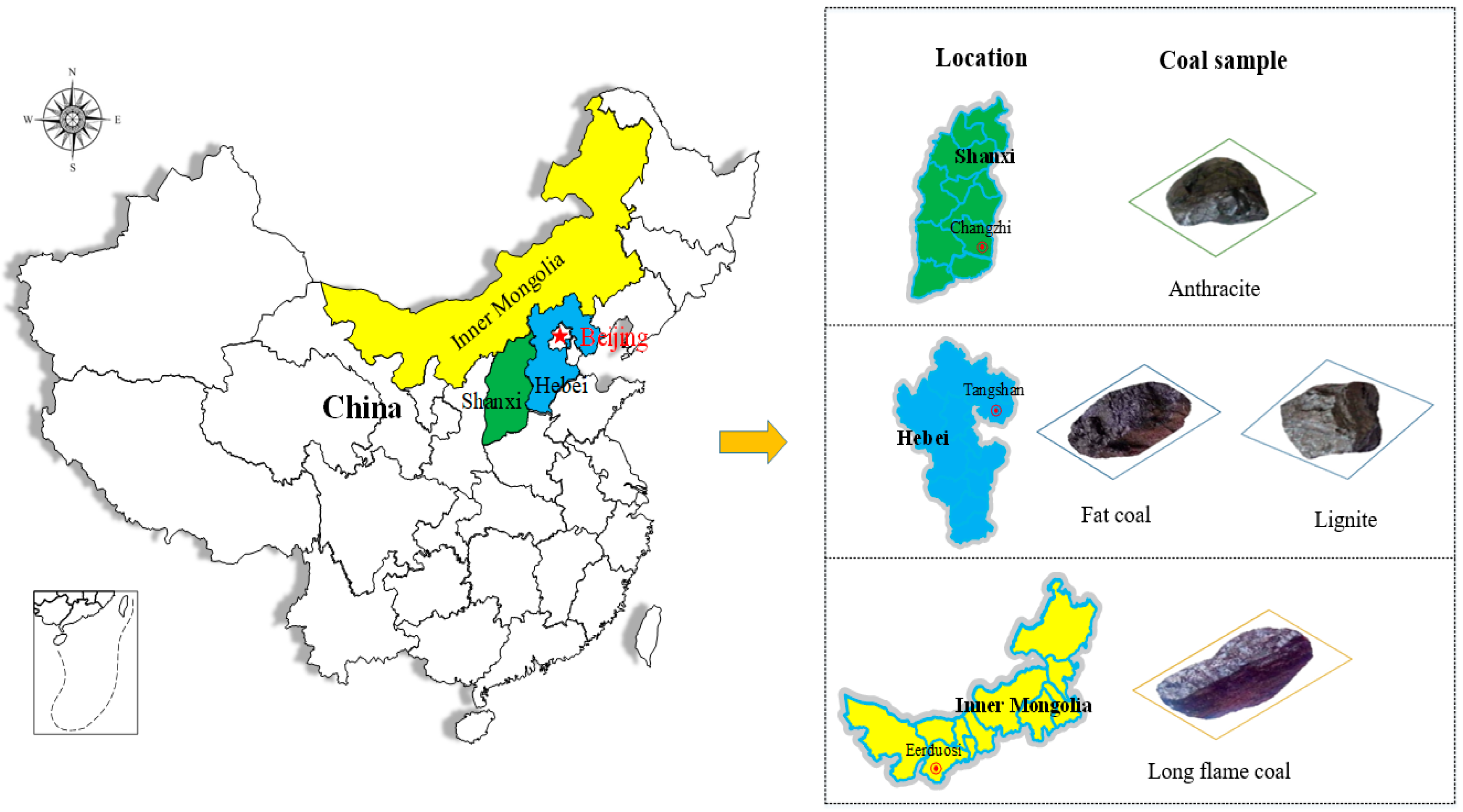
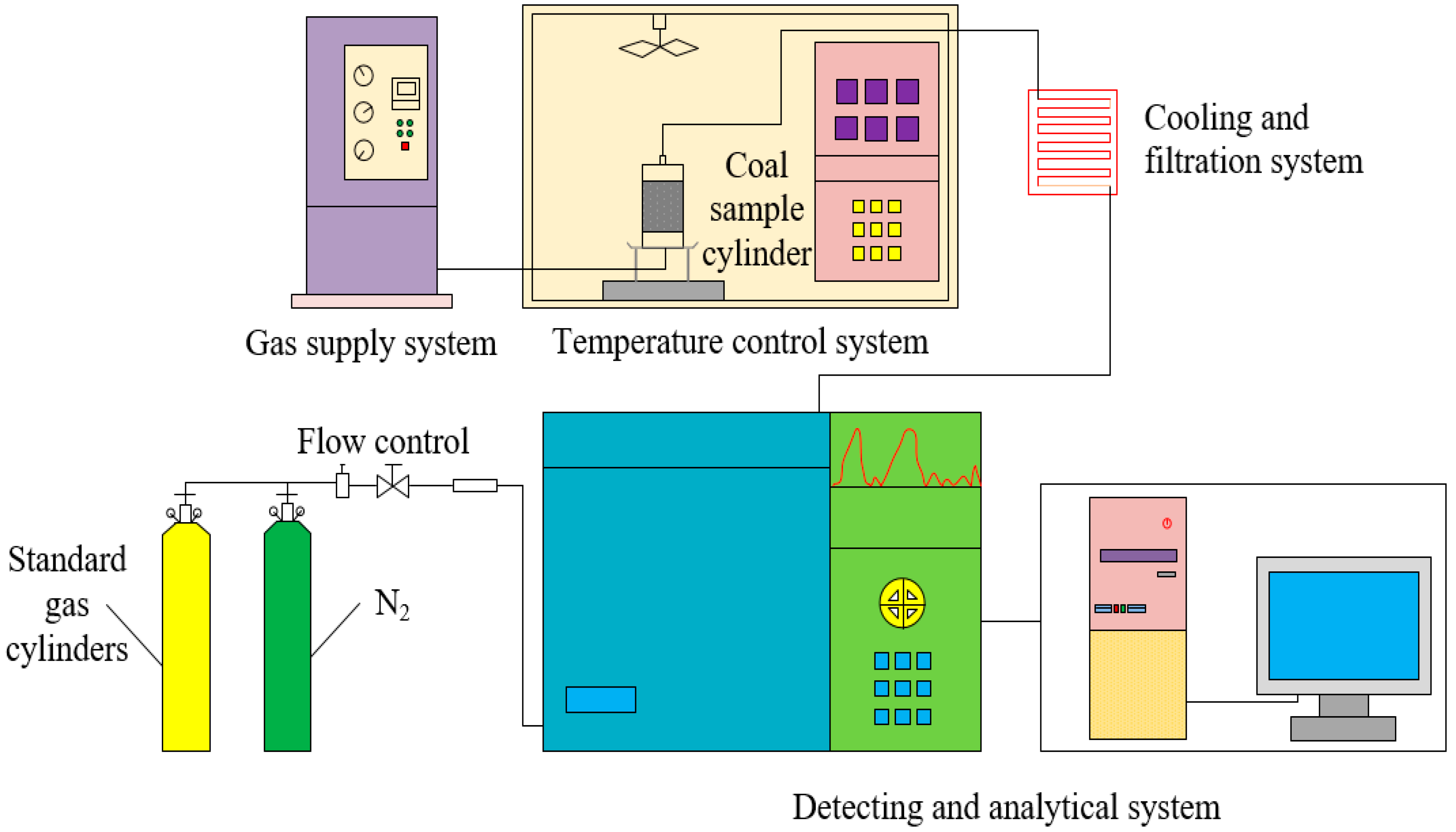
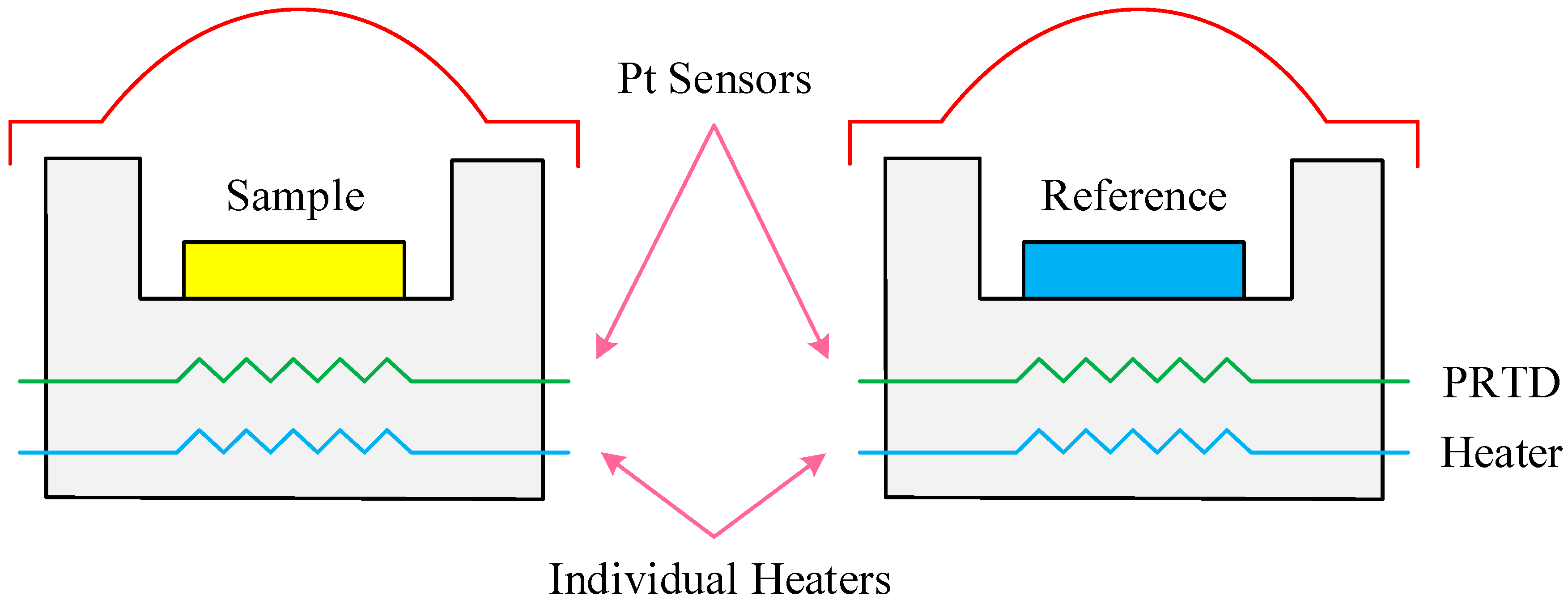
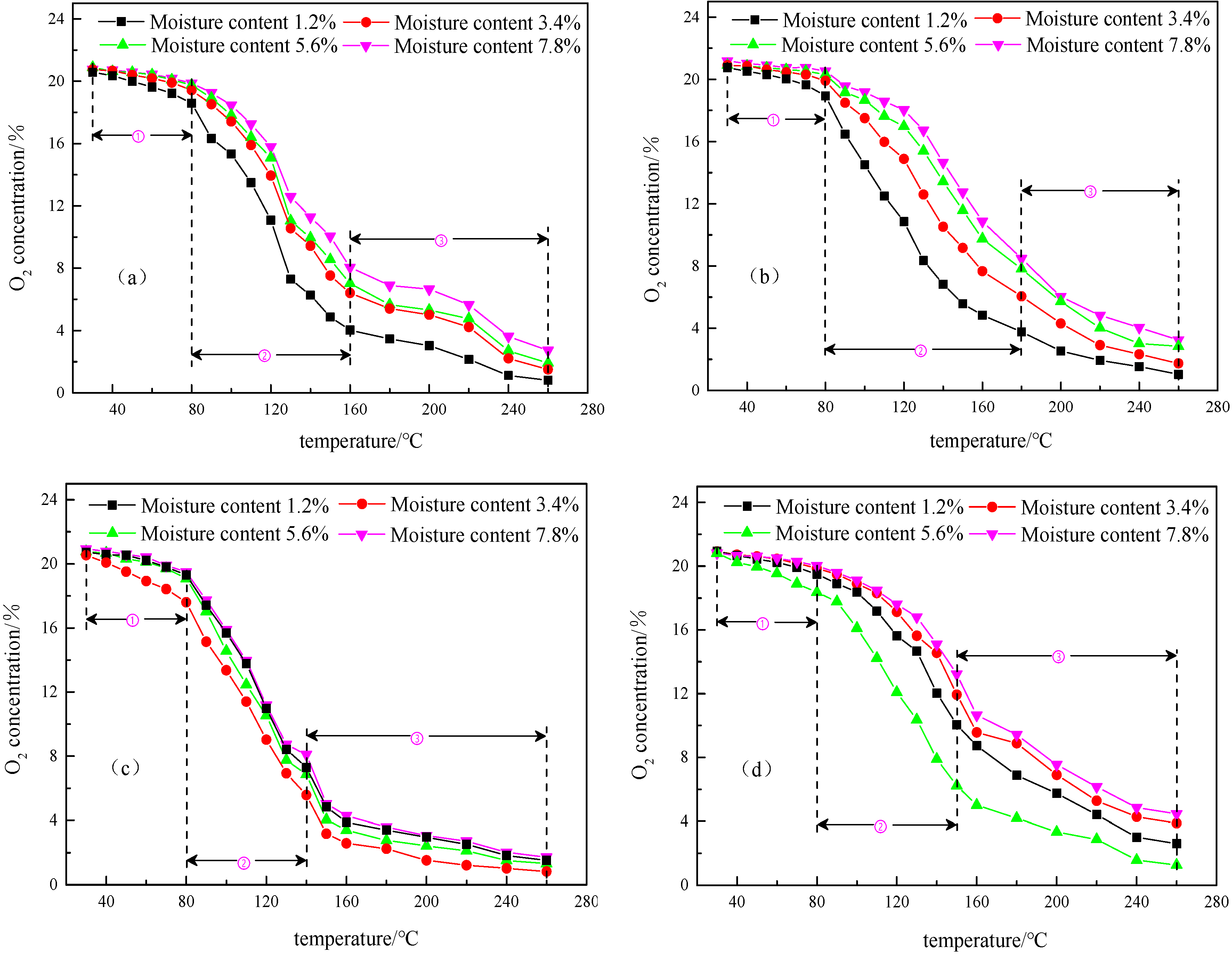


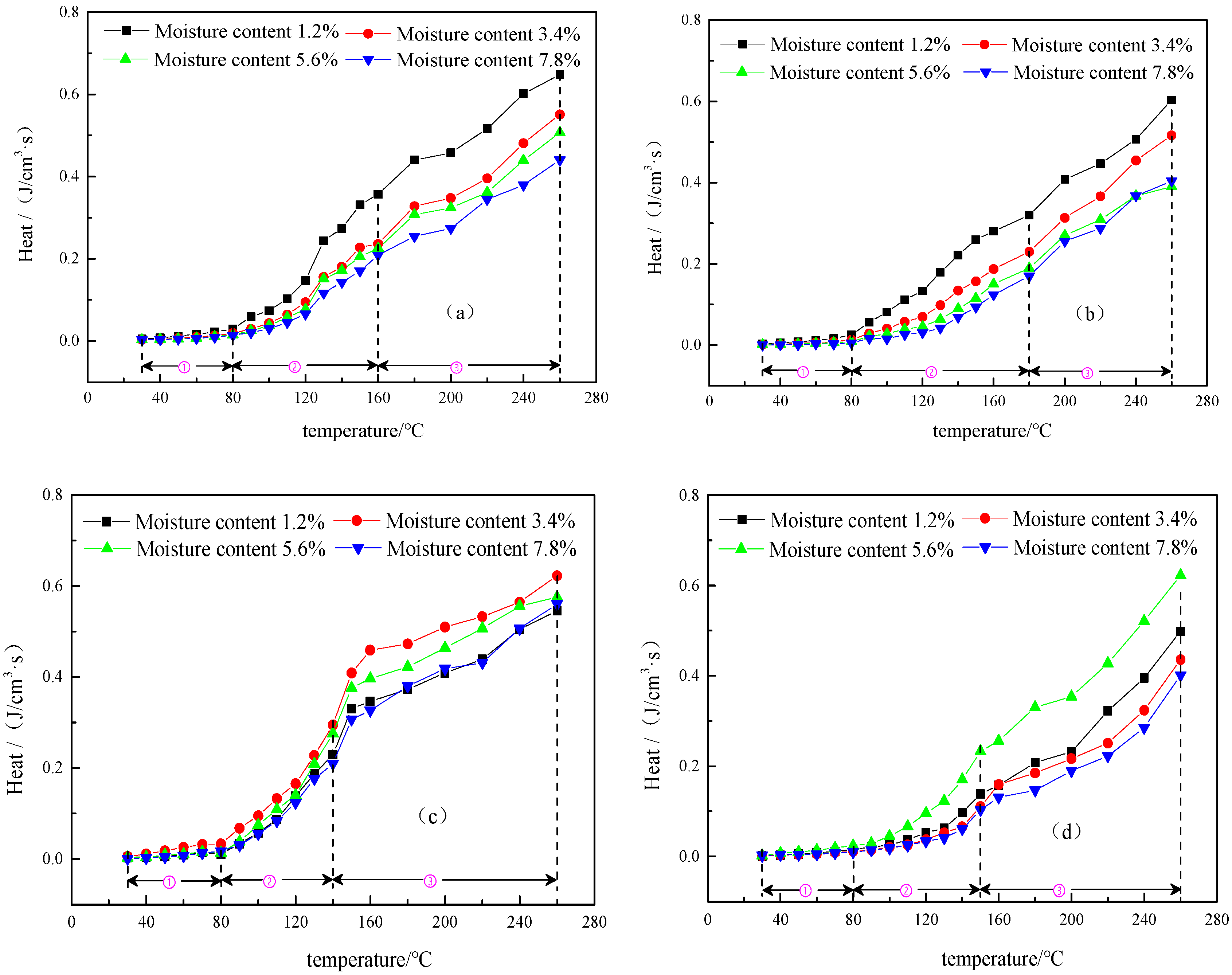
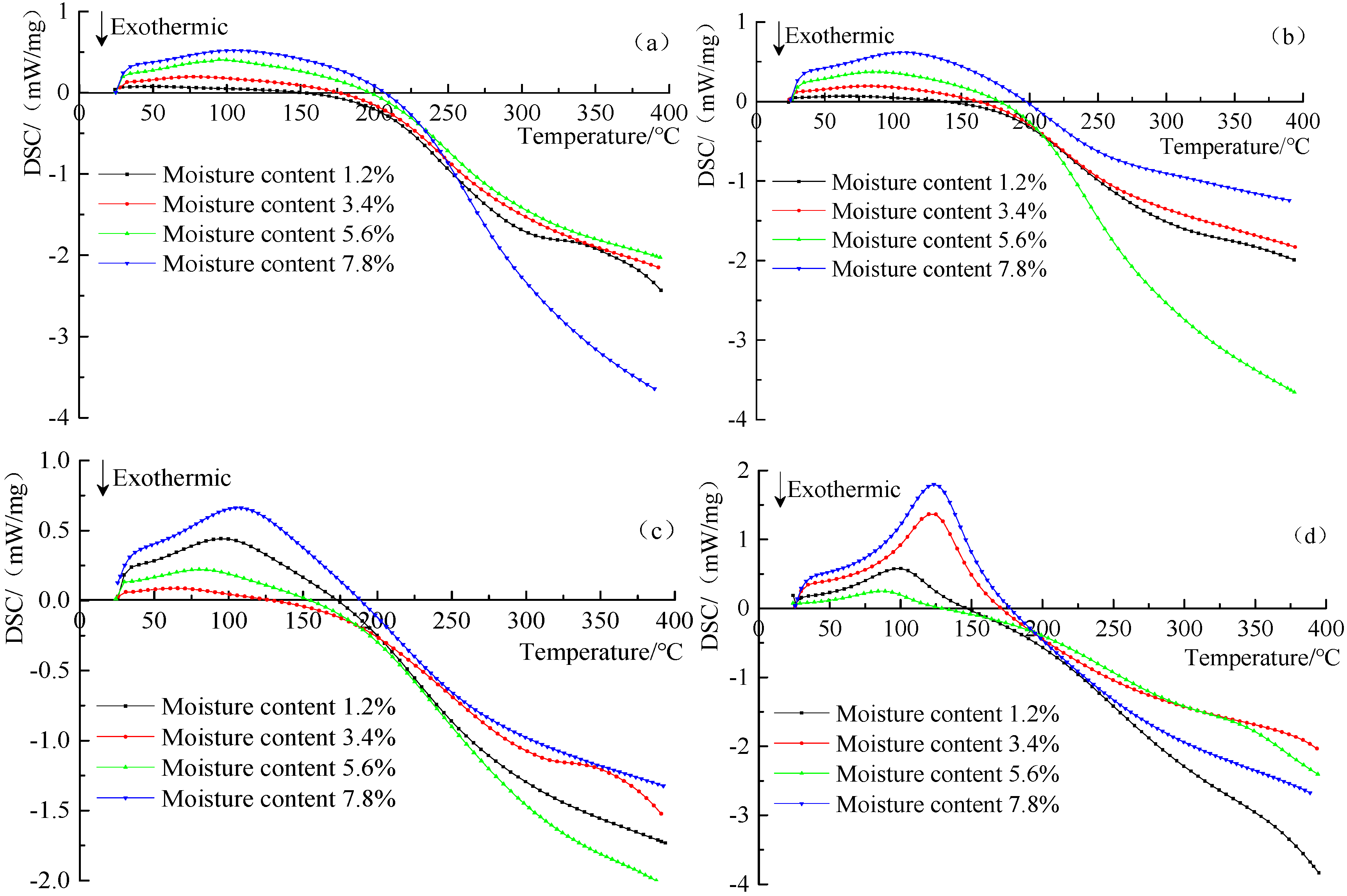
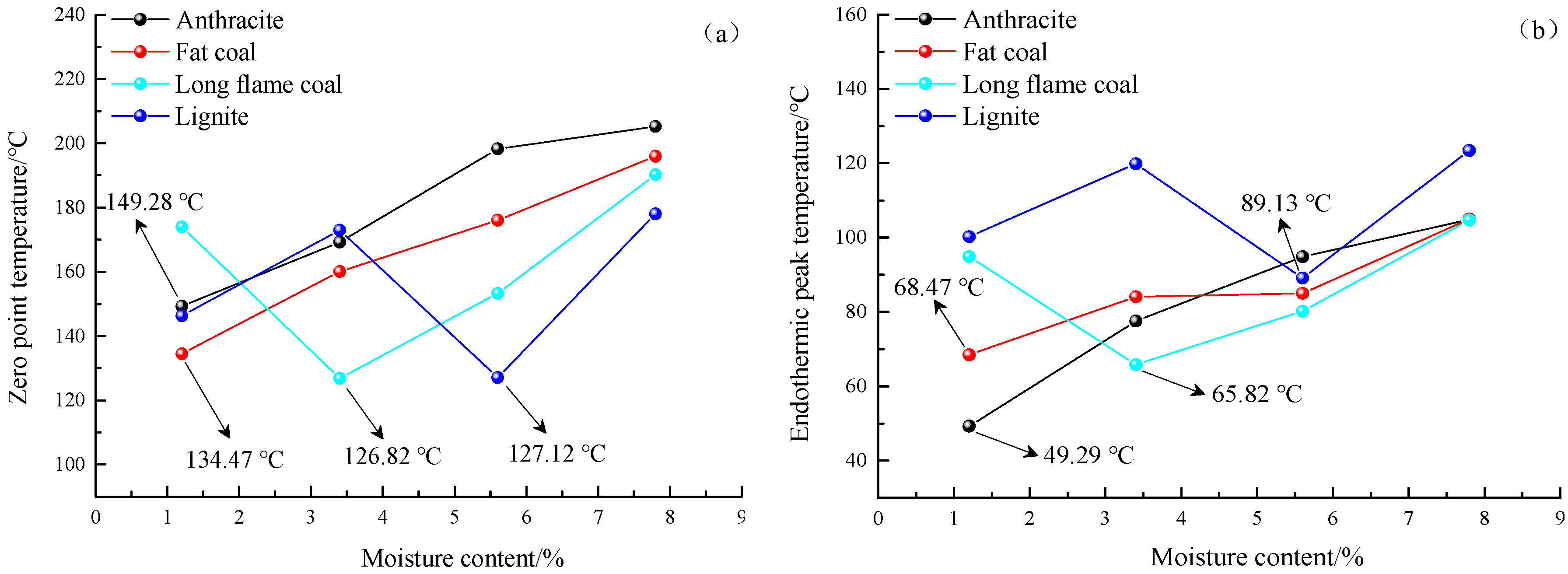

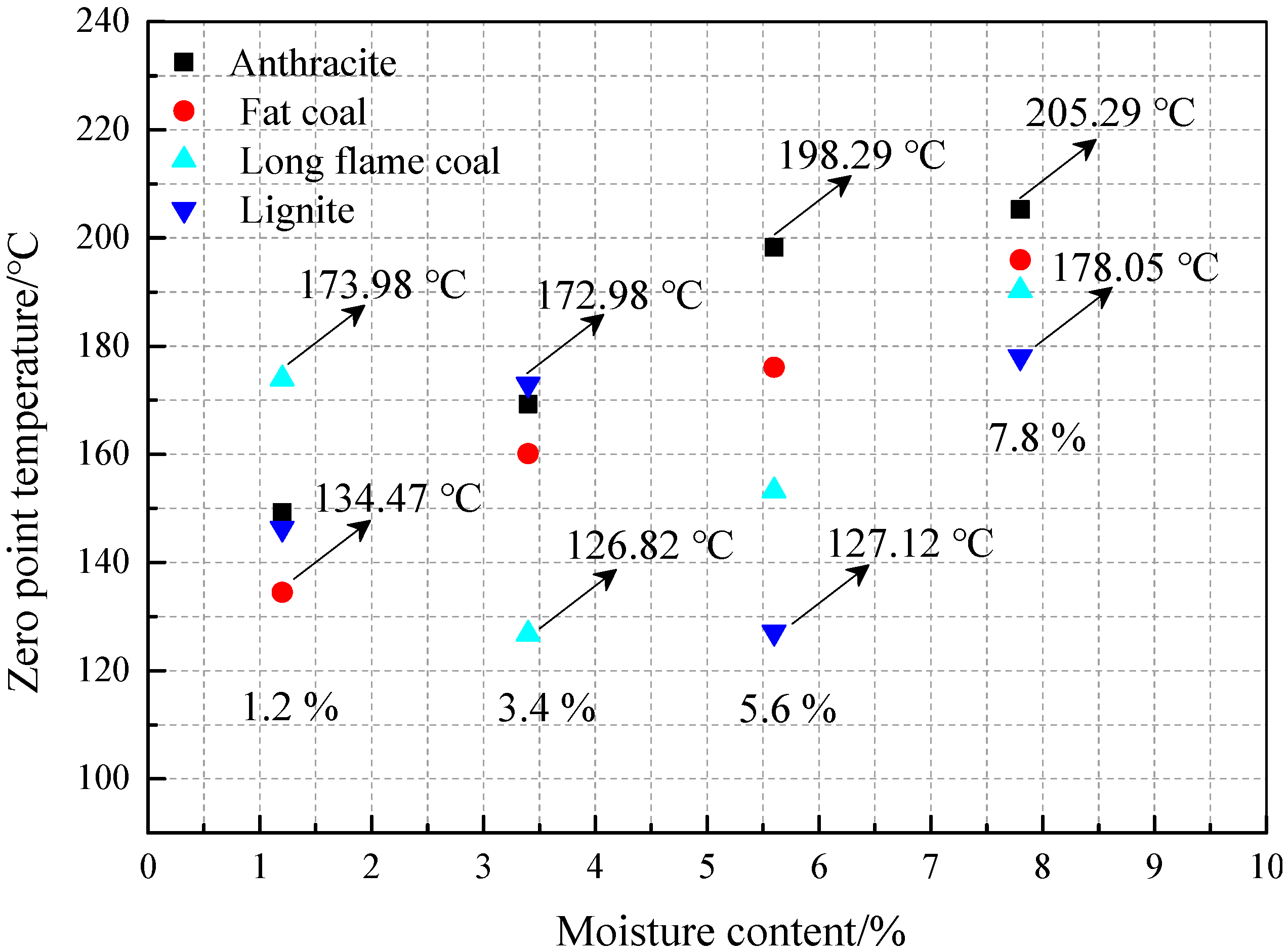
| Coal Samples | Proximate Analysis (%) | |||
|---|---|---|---|---|
| Misoture (Mad) | Ash (Aad) | Volatiles (Vad) | Fixed Carbon (FCad) | |
| Changcun | 0.845 | 11.795 | 11.190 | 76.170 |
| Fangezhuang | 1.995 | 8.960 | 26.615 | 62.430 |
| Neimenggu | 2.895 | 28.250 | 24.190 | 44.665 |
| Cuijiazhai | 12.145 | 8.990 | 33.550 | 45.315 |
© 2019 by the authors. Licensee MDPI, Basel, Switzerland. This article is an open access article distributed under the terms and conditions of the Creative Commons Attribution (CC BY) license (http://creativecommons.org/licenses/by/4.0/).
Share and Cite
Fan, J.; Wang, G.; Zhang, J. Study on Spontaneous Combustion Tendency of Coals with Different Metamorphic Grade at Low Moisture Content Based on TPO-DSC. Energies 2019, 12, 3890. https://doi.org/10.3390/en12203890
Fan J, Wang G, Zhang J. Study on Spontaneous Combustion Tendency of Coals with Different Metamorphic Grade at Low Moisture Content Based on TPO-DSC. Energies. 2019; 12(20):3890. https://doi.org/10.3390/en12203890
Chicago/Turabian StyleFan, Jiuyuan, Gang Wang, and Jiuling Zhang. 2019. "Study on Spontaneous Combustion Tendency of Coals with Different Metamorphic Grade at Low Moisture Content Based on TPO-DSC" Energies 12, no. 20: 3890. https://doi.org/10.3390/en12203890
APA StyleFan, J., Wang, G., & Zhang, J. (2019). Study on Spontaneous Combustion Tendency of Coals with Different Metamorphic Grade at Low Moisture Content Based on TPO-DSC. Energies, 12(20), 3890. https://doi.org/10.3390/en12203890




